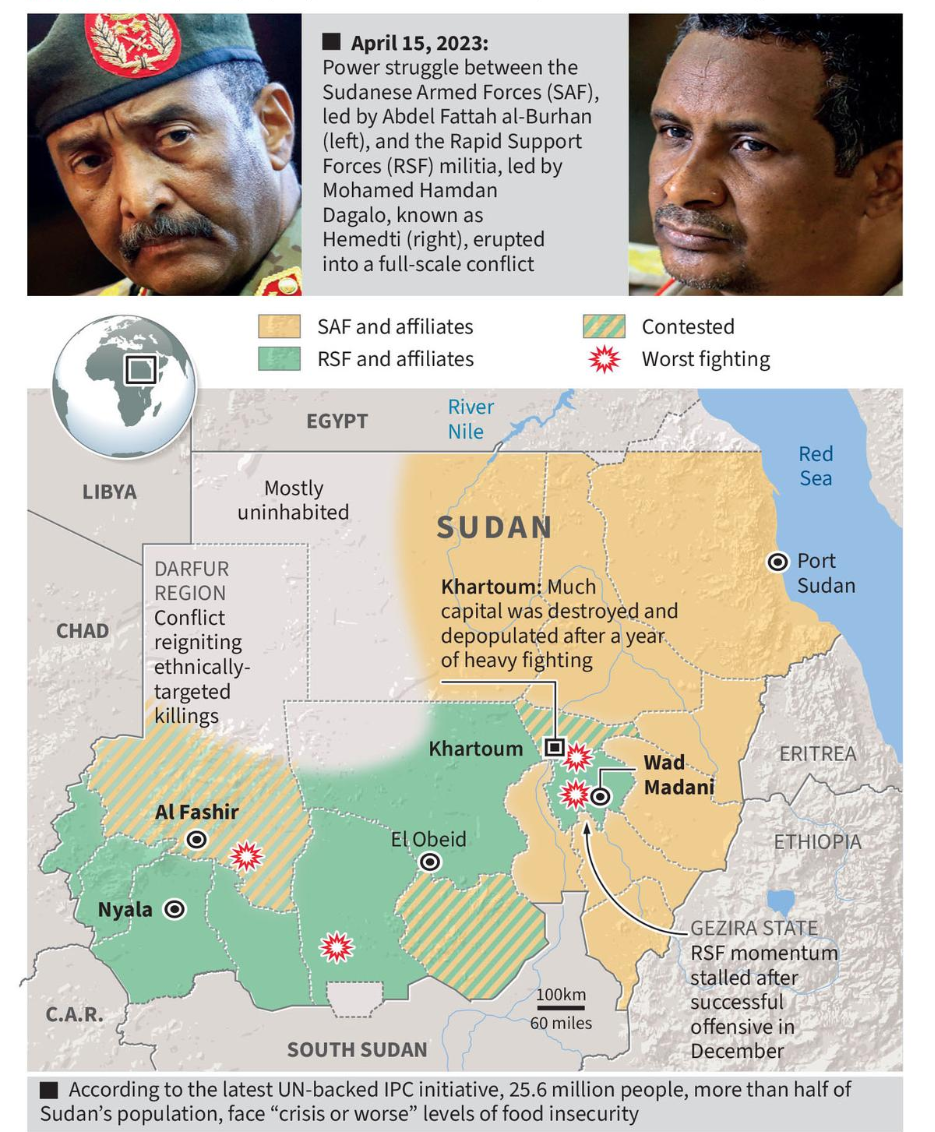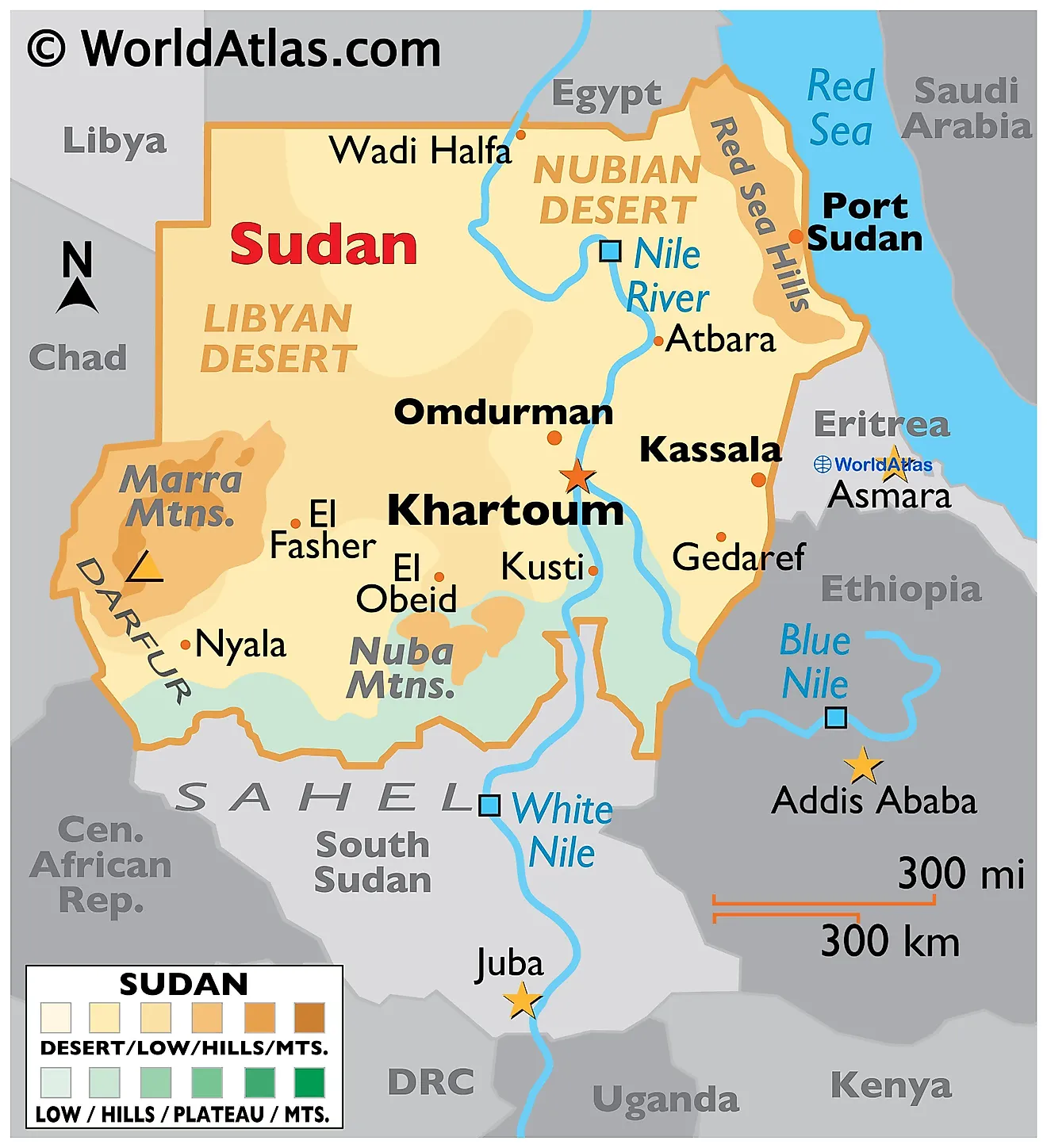Important Facts For Prelims
Civil War in Sudan
- 11 Oct 2024
- 5 min read
Why in News?
Recently,the Sudanese Armed Forces (SAF) launched a significant offensive against the Rapid Support Forces (RSF) in Khartoum and Bahri, reigniting a conflict that had quieted for several months.
- This renewed offensive comes amid a civil war that has persisted for over 18 months, with more than 20,000 deaths reported and nearly 11 million people displaced as of October 2024.
What is the Origin of Civil War in Sudan?
- The war is rooted in a power struggle between SAF leader Abdel Fattah al-Burhan and RSF leader Hamdan Dagalo (Hemedti).
- It started in Khartoum but has spread to other regions like Omdurman, Bahri, Port Sudan, and the Darfur and Kordofan states.
- Historical Background:
- Sudan was a joint protectorate under Egypt and the UK during the Anglo-Egyptian Condominium.
- Sudan gained independence in 1956, facing internal challenges between the wealthier Arab Muslim north and the Christian/Animist south.
- Two major civil wars, first (1955-1972) and Second (1983-2005), led to the deaths of millions, atrocities, and eventually leading to the secession of South Sudan in 2011.
- The second civil war ended with a peace agreement in 2005, but tensions and internal conflict remained, particularly in Darfur.
- Omar al-Bashir’s Regime:
- Bashir took power in a 1989 coup and ruled Sudan for 30 years.
- He imposed a strict interpretation of sharia law, used private militias (Janjaweed) to fight rebels, and persecuted minority religions.
- Bashir's regime was condemned for genocide in Darfur, particularly targeting non-Arab groups like the Fur, Zaghawa, and Masalit.
- Bashir's Overthrow:
- By 2019, protests against Bashir’s oppressive rule intensified, leading to his removal in an April coup supported by both SAF and RSF.
- After his overthrow, Sudan entered a transitional phase under military and civilian leadership.
- RSF’s Origin and Power:
- RSF emerged from the Janjaweed militia, a key force in the Darfur conflict responsible for widespread atrocities.
- Formally organized in 2013, the RSF gained wealth and influence especially through control over gold mines.
- Transitional Government:
- After Bashir’s fall, a Transitional Sovereignty Council was formed.
- Prime Minister Abdalla Hamdok, a civilian leader, sought economic stability but was ousted in a 2021 coup led by the SAF and RSF. Later his resignation left Sudan without effective civilian leadership.
- The December 2022 Deal:
- The December 2022 agreement outlined a two-year transition to civilian rule.
- However, tensions emerged over RSF integration into the armed forces, with Burhan and Hemedti disagreeing on timelines.
- The involvement of foreign actors, such as the Wagner Group and military support from UAE, has complicated the conflict, making it harder to resolve.
What are the Reasons for Persistent Conflict in Sudan?
- Power Struggle: Both the SAF and RSF are determined to consolidate power, with each faction seeking dominance over the other.
- The SAF claims to be the legitimate government, while the RSF challenges it.
- Weapon Supply: Despite an arms embargo by the United Nations since the 2004 Darfur crisis, weapons continue to flow into the country.
- Advanced military equipment, often supplied by Russia, China, and UAE.
- Ethnic Tensions: The conflict has taken on an ethnic dimension.
- Eg. In Darfur, Arab militias support the RSF, while non-Arab communities like the Masalit back the SAF.
- Foreign Interference: Each side is receiving external support, reducing their incentive to compromise or seek peace.
- Failed Peace Talks: Despite numerous ceasefire efforts, particularly led by Saudi Arabia and the US like the Jeddah Declaration (2023), none have succeeded.






